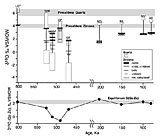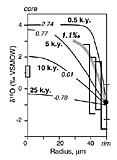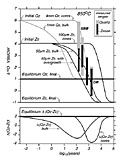Formation of Low-d18O Rhyolites After Caldera Collapse at Yellowstone, Wyoming, USA
Bindeman, Ilya N. and Valley, John W., (2000) Formation of low-d18O rhyolites after caldera collapse at Yellowstone, Wyoming, USA. Geology, v. 28, n. 8, p. 719-722
We present a new model for the genesis of low-d18O rhyolites of the Yellowstone caldera based on analyses of zircons and individual quartz phenocrysts. Low-d18O rhyolites were erupted soon after the massive caldera-forming Lava Creek Tuff eruption (602 k.y., ~1000 km3) and contain xenocrysts of quartz and zircon, inherited from precaldera rhyolites. These zircons are isotopically zoned and out of equilibrium with their host low-d18O melts, and quartz. Diffusion modeling predicts that magmatic disequilibria of oxygen isotopes persists for up to tens of thousands of years following nearly total remelting of the hydrothermally altered igneous roots of the depressed cauldron, in which the alteration resistant quartz and zircon initially retained their d18O values. These results link melting to caldera collapse, rule out rapid or catastrophic magma-meteoric water interaction, and indicate wholesale melting rather than assimilation or partial melting.
| Figure 1. Oxygen isotope ratios of larger and smaller zircons, measured compositions of abraded cores and calculated compositions of rims in low-d18O rhyolites from Yellowstone Caldera, Wyoming. Boxes show ranges of quartz d18O values. These data show (1) variablity of d18O values among individual quartz phenocrysts, especially for low-d18O lavas erupted after LCT at 550-450 k.y.; (2) variability of different size zircons and air abraded cores; (3) disequilibria between average quartz and zircon in most low-d18O lavas. LCT - Lava Creek Tuff; CF - Canyon Flow, DRF -Dunraven Road flow, SBBF, MBBF and NBBF are South, Middle and North Biscuit Basin flows, SCLF - Scaup Lake flow, MLF - Mallard Lake flow, WYF- West Yellowstone flow; ACF - Aster Creek flow. Ages are from Gansecki et al. (1996, 1998) and Obradovich (1992). Plotted ages of post-LCT lavas are not exact to prevent overlap of data points. Note, that oxygen isotopes permit making of stratigraphic distinctions. Our results show that three separate outcrops (hills), southern, middle, and northern, along Firehole River of the Upper Geyser Basin, defined earlier as a single unit of Biscuit Basin flow represent three independent lava flows, which have distinctly different isotope compositions of phenocrysts. We hereby call them South, Middle and North Biscuit Basin flows. Only Middle Biscuit Basin was sampled by Hildreth et al. (1984). NBBF and SBBF ages were not determined. |
| Figure 2. Zoning profile of d18O in 105 Ám zircons (52.5 Ám radius) for magma residence times in Middle Biscuit Basin flow based on successive air abrasions (thick curve). Left-oriented horizontal marks on vertical lines at 40 — 50 Ám are measured core compositions; horizontal marks at the bottom are the rim composition. Rim composition was calculated by mass balance using measured d18O of core, d18O of pre-abrasion bulk, and percentage of abrasion (% of material removed). Thin curves indicate calculated diffusion profiles (see text). Numbers in per mil are d18O of the whole grain, calculated (italic) and measured (bold). Stripped box is the measured compositional range of host obsidian. Notice the steep isotopic gradients predicted for residence times of 500-10 000 yr. Compositions of rims, based on analyses of prismatic faces of four individual zircon crystals by the ion microprobe, are shown as filled circle (▒1s ). d18O values of measured and predicted rims are 2‰ to 4‰ lower than those of the bulk of zircon, the abraded cores and the smallest measured zircons, but the rims are in equilibrium with the host obsidian (see Fig. 1). |
| Figure 3. a: Calculations of isotopic exchange of normal zircon (d18O =+4.0‰, thick lines) and quartz (+6.0‰, dotted lines) crystals (sizes are diameters) immersed into a low-d18O melt (0.0‰) predict a period of quartz-zircon disequilibrium for residence times up to 50 k.y. b: Up to 5.5‰ disequilibrium in D (Qz-Zrc) exists during the time intervals up to 50 k.y. See Figure 1 for unit abbreviations and text for discussion. Each core is the innermost 50% of crystal's radius. Overgrowth implies constant rate of deposition of new rim (d18O = -1‰) in equilibrium with melt at rate of 10-15cm/s (Watson, 1996). |
| Figure 4. Model of genesis of low-d18O rocks by total fusion of hydrothermally altered caldera roots after caldera collapse. Quartz and zircon were not altered by hydrothermal fluids and retained precaldera higher-d18O values. Purely conductive heating of D T=200-300 ° C of the depressed cauldron with vertical dimension of ~500m, proceeding at thermal diffusivity of 0.005 cm2/s would yield a heating on the order of 10-2 degrees per yr (Carslaw and Jagger, 1959). At this heating rate from Tsolidus to Tmax (700° to 850 ° C) zircon growth rate is on the order of 10-16 to 10-17 cm/s (Watson, 1996). If zircon saturation temperature is exceeded at higher temperatures (e.g., T~850 ° C), zircon dissolution may proceed at <10-15 cm/s, followed by crystallization of overgrowth during eruptive cooling. Given the short time scale involved (a few hundreds to a few thousands of years, based on the diffusive exchange alone) both overgrowth and dissolution are expected to play a secondary role in oxygen exchange. |



